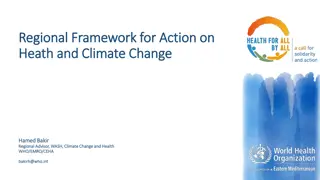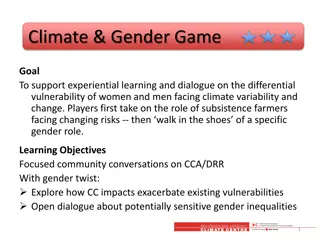Climate Change and the Health of Pregnant Women: Risks and Vulnerabilities
Climate change poses significant risks to the health of pregnant women, increasing vulnerability due to exposure sensitivity and lack of adaptation capacity. Environmental hazards like air pollutants, extreme heat, and contaminated water can lead to adverse birth outcomes such as low birth weight and pre-term birth. Pregnant women and fetuses are particularly vulnerable, making it crucial to address these challenges for better maternal and child health.
Download Presentation

Please find below an Image/Link to download the presentation.
The content on the website is provided AS IS for your information and personal use only. It may not be sold, licensed, or shared on other websites without obtaining consent from the author.If you encounter any issues during the download, it is possible that the publisher has removed the file from their server.
You are allowed to download the files provided on this website for personal or commercial use, subject to the condition that they are used lawfully. All files are the property of their respective owners.
The content on the website is provided AS IS for your information and personal use only. It may not be sold, licensed, or shared on other websites without obtaining consent from the author.
E N D
Presentation Transcript
Climate Change and the Health of Pregnant Women
The US Climate Health Assessment What is it? An assessment of the risks climate change poses to human health in the United States An Interagency product of the US Global Change Research Program (USGCRP) Part of the ongoing National Climate Assessment (NCA) process Who wrote it? A team of ~100 Federal employees, contractors, and grantees from eight U.S. Federal agencies: HHS (NIH, CDC, NIOSH, ASPR, FDA, SAMHSA), NOAA, EPA, USDA, NASA, USGS, DOD (USUHS), VA. Health2016.globalchange.gov Climate change is a significant threat to the health of the American people.
Vulnerability Vulnerability is the tendency or predisposition to be adversely affected by climate-related health effects, and encompasses three elements: exposure sensitivity or susceptibility to harm the capacity to adapt to or respond to a climate change threat. While all Americans are affected by climate change, some groups are disproportionately vulnerable to climate health impacts.
What Makes Pregnant Women Vulnerable? Most women have healthy pregnancies and healthy babies. However, pregnant women and fetuses are more sensitive to some environmental hazards. Climate change can worsen environmental hazards that threaten the health of pregnant women and increase health risks for the baby, such as: Low weight of the baby at birth. If a baby weighs less than 5.5 pounds at birth, there may be lasting effects on health. Pre-term birth. Labor that starts before 37 weeks of pregnancy is considered pre-term, and may lead to health problems.
Environmental Hazards Air pollutants can cause respiratory illness in pregnant women and can also lead to low birth weight or pre-term birth. Extreme heat can cause dehydration early in pregnancy, which can affect the baby s growth and can cause pre- term birth. Contaminated water or food can lead to poor nutrition and diarrhea, which have been linked to negative birth outcomes such as low birth weight. Weather-related disasters can cause severe stress and negative mental health outcomes for pregnant and post- partum women. Severe maternal stress can increase the risk of negative outcomes such as pre-term birth.
For More Information Factsheet: Climate Change and the Health of Pregnant Women www.epa.gov/climate-impacts/communicating- vulnerabilities-climate-change-pregnant-women
Additional Resources EPA Resources: www.epa.gov/climate-impacts USGCRP Climate and Health Assessment: health2016.globalchange.gov























